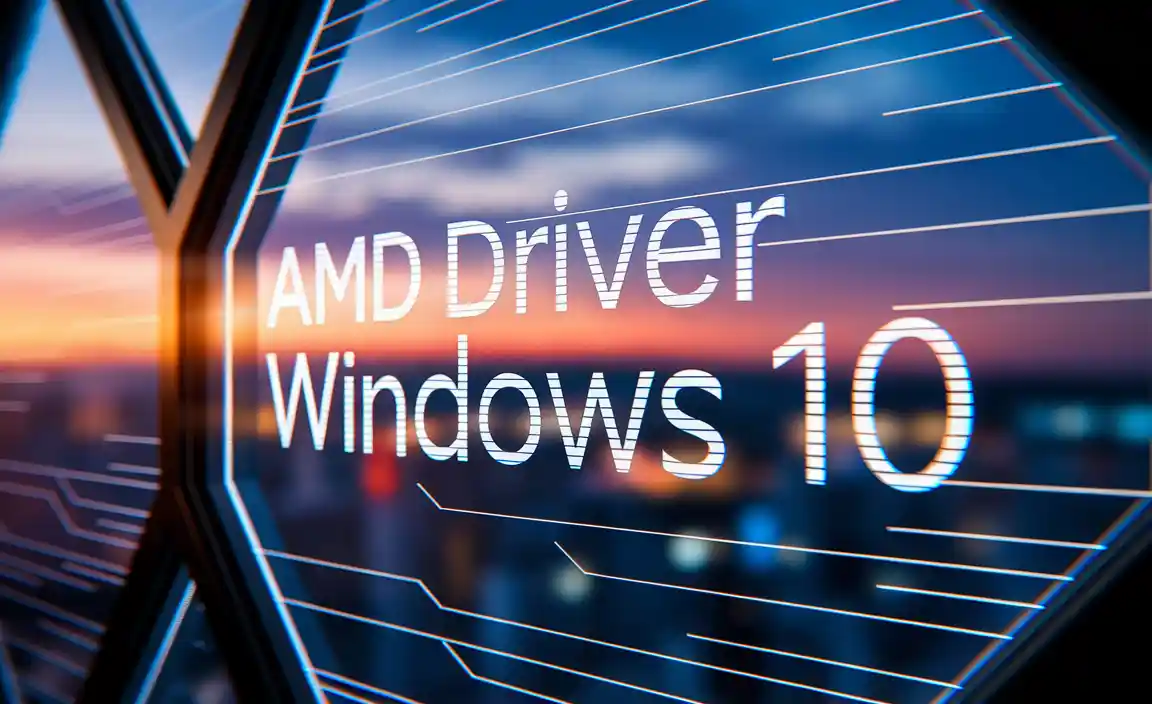AMD Driver Windows 10: Easy Update
Keeping your AMD drivers up-to-date on Windows 10 is a crucial step for ensuring optimal performance, stability, and access to the latest features for your graphics card. Whether you’re a gamer seeking smoother frame rates, a creative professional relying on accelerated applications, or simply want a more responsive and bug-free computing experience, a current amd driver for windows 10 is fundamental. Fortunately, the process of updating these drivers is generally straightforward and accessible to users of all technical backgrounds.

One of the primary reasons to regularly update your AMD drivers is performance enhancement. Graphics card manufacturers, like AMD, constantly work to optimize their drivers for new games and software. These updates often include performance tweaks and bug fixes that can translate to noticeable improvements in frame rates, reduced stuttering, and faster loading times in your favorite titles. Beyond gaming, updated drivers can also boost the performance of creative applications such as video editors, 3D rendering software, and CAD programs, making your workflow more efficient.
Beyond raw performance, driver updates play a significant role in system stability. Software bugs can emerge over time, and these can manifest as crashes, visual glitches, or even system-wide instability. AMD frequently releases driver updates that address these known issues, ensuring a smoother and more reliable experience with your computer. This is particularly important if you’ve recently upgraded your operating system or installed new software, as compatibility issues can sometimes arise without the latest drivers.
Furthermore, driver updates often introduce support for new technologies and features. This could include support for newer DirectX versions, improved Vulkan API performance, or enhancements to AMD’s proprietary technologies like AMD Radeon™ Software Adrenalin Edition. Staying current ensures you can take full advantage of the hardware you own and the software you use.
Finding the Right AMD Driver for Windows 10
The good news is that AMD provides several convenient methods for users to find and install the correct amd driver for windows 10. The most recommended and often easiest approach is to utilize AMD’s official tools. The primary method involves visiting the AMD Support website. Here, you can manually select your product from a dropdown menu, specifying your graphics card model and operating system. This ensures you download the precise driver tailored for your hardware.
Alternatively, AMD offers an “Auto-Detect and Install” utility. This powerful tool scans your system, identifies your AMD hardware, and then automatically downloads and installs the most appropriate driver package. This is an excellent option for users who are unsure of their exact graphics card model or prefer a completely automated solution. Simply download the utility from AMD’s support page, run it, and follow the on-screen prompts.
Step-by-Step Guide to Updating Your AMD Drivers
While the auto-detect tool simplifies things, understanding the manual process is also beneficial.
1. Identify Your Graphics Card: If you’re unsure of your graphics card model, you can find this information in Windows. Right-click on the Start button and select “Device Manager.” Expand the “Display adapters” section, and your AMD graphics card name will be listed.
2. Visit the AMD Support Website: Navigate to the official AMD Support page (usually found by searching “AMD Drivers” on your preferred search engine).
3. Select Your Product or Use Auto-Detect:
Manual Selection: Choose “Graphics” from the product category. Then, select your product series (e.g., Radeon RX Series) and your specific product model (e.g., Radeon RX 6800 XT). Choose your operating system (Windows 10 64-bit is most common).
Auto-Detect: Download and run the AMD Radeon™ Software installer, which has the auto-detect functionality built-in.
4. Download the Driver: After selecting your product or letting the auto-detect tool work, locate the latest driver package. AMD typically offers different versions, such as the “Recommended (WHQL Certified)” for maximum stability or the “Optional” version which might include newer features or performance improvements but hasn’t undergone the same level of rigorous testing. For most users, the Recommended version is the best choice. Click the “Download” button.
5. Run the Installer: Once the download is complete, locate the downloaded file (usually an executable `.exe` file) and double-click it to start the installation process.
6. Follow On-Screen Instructions: The AMD installer will guide you through the process. You’ll typically see options for a “Quick Install” or “Custom Install.” A Quick Install is generally sufficient for most users, automatically installing all necessary components. A Custom Install allows you to choose specific driver components to install or uninstall, which can be useful for troubleshooting or if you have specific preferences.
7. Reboot Your Computer: After the installation is finished, it’s crucial to restart your computer. This allows the newly installed drivers to be fully integrated into your system.
Troubleshooting Common Issues
While the update process is usually smooth, occasional issues can arise. If you encounter problems:
Display Issues After Update: If your screen resolution is incorrect or you experience graphical artifacts after an update, you might need to perform a clean installation. The AMD installer typically offers a “Factory Reset” or “Clean Install” option during the custom installation. This removes all previous driver files before installing the new ones, preventing conflicts.
Driver Installation Fails: Ensure you’ve downloaded the correct driver for your specific graphics card and Windows 10 version. Sometimes, corrupted downloads can cause installation failures. Try re-downloading the driver. Also, temporarily disabling your antivirus software during the installation can sometimes resolve persistent issues, but remember to re-enable it afterward.
* Performance Issues Persist: If you’re still experiencing performance problems after updating, it’s worth checking user forums and AMD’s support page for any known issues related to the specific driver version and your hardware. Sometimes, a rollback to a previous stable driver version might be necessary, or a future driver update may resolve the problem.
By diligently keeping your amd driver for windows 10 updated, you ensure your graphics card performs at its peak, contributing to a more enjoyable and productive computing experience. The tools and resources provided by AMD make this process accessible and manageable for everyone.
